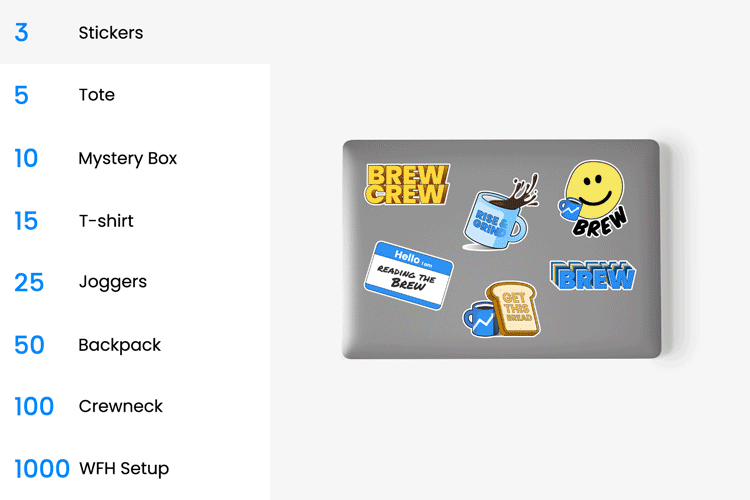|
|
|
|
|
|

It’s the most wonderful time of the year…Arturo Holmes/Getty Images
|
|
|
The wackiest headlines from the week as they would appear in a Classifieds section.
Careers
FATHER WHO PREFERS FUNK: A Catholic priest allowed pop star Sabrina Carpenter to film parts of her new music video, “Feather,” in his Brooklyn church, but now he’s in trouble with his diocese.
MOLE DETECTIVE (MUST BE A DOG): A rare golden mole—last spotted in 1936—was discovered in South Africa when a trained border collie named Jessie sniffed out the elusive creature in the sand. Jessie’s sister Jenny does a similar job in dermatology offices.
HYPE MAN: Deion Sanders, the bombastic coach of the University of Colorado football team, was somehow selected as Sports Illustrated’s Sportsperson of the Year…despite going 4–8 in his first season as head coach.
Personal
SHAME, SHAME, SHAME: Forbes’s 30 Under 30, which annually highlights the most overachieving startup founders, released a Hall of Shame to highlight some people it’s recognized whose work has not aged so gracefully. At the top of the list is SBF, obvi.
FOUNTAIN OF YOUTH: Henry Kissinger, who died this week at 100, outlived the obituary writer of his obituary writer.
For sale
SALAD—HOLD THE DIGITS: A woman is suing Chop’t Creative Salad Company because it allegedly served her a salad that contained part of a severed finger. We felt the same way when they tried to give us beetroot.
MAC & BEANS: Kraft Heinz Co. is rolling out a new dairy-free blue box in the US that’s made with coconut oil powder and fava bean protein. It’s the ideal quick meal for any little boy or a drunk 23-year-old with a delicate stomach.—MM
|
|
|
|
|
We’ve all had one of those road trips. Bored passengers, missed turns due to spotty cell service, and endlessly scanning the radio for something to listen to.
Fortunately, your next road trip can look (and feel) a lot more peaceful, thanks to AT&T In-car Wi-Fi. Now everyone on board can stream video, listen to music, play games, and chat with friends.
When we say anywhere, we mean it. AT&T covers more roads than any other carrier,* helping you stay connected on interstates, city streets, and country roads.
And just in time for holiday travel, you can get four days of AT&T In-car Wi-Fi totally free.
Sign up today.
|
|
|
|
Indonesian Ministry of Environment and Forestry
No, you cannot pet that dog. This baby Sumatran rhino was born in Indonesia last Saturday, a huge boost for a critically endangered species with fewer than 50 members. The yet unnamed male weighed in at 55 pounds and is the fifth rhino born at the Sumatran Rhino Sanctuary in Way Kambas National Park since 2012 as part of a government effort to preserve the species.
|
|
|
Justus Sustermans/meme by Neal Freyman
Here are some illuminating scientific discoveries from the week to help you live better and maybe even observe a tear in the fabric of space-time.
 Study finds no evidence that the internet harms mental health. Contrary to the mounting research that ties the mental health crisis to the internet, a new report from the Oxford Internet Institute found no causal relationship between the two. The study cross-referenced the psychological well-being of 2.4 million people in 168 countries with internet adoption trends over nearly two decades. The sample size is much broader than in similar studies, which tend to focus on English-speaking countries, the researchers say. They also concluded that if the internet is harming mental health, it can only truly be proven with user data collected by the tech companies behind the web’s most popular apps and services. Study finds no evidence that the internet harms mental health. Contrary to the mounting research that ties the mental health crisis to the internet, a new report from the Oxford Internet Institute found no causal relationship between the two. The study cross-referenced the psychological well-being of 2.4 million people in 168 countries with internet adoption trends over nearly two decades. The sample size is much broader than in similar studies, which tend to focus on English-speaking countries, the researchers say. They also concluded that if the internet is harming mental health, it can only truly be proven with user data collected by the tech companies behind the web’s most popular apps and services.
 Your home could be a virtual power plant. EVs, data centers, and air conditioning are driving electricity demand sky-high in the US, but the Department of Energy predicts that half of the new juice the country needs could soon be provided by people and businesses with smart technology. By discharging unused power back to the grid or limiting consumption, incentivized industrial customers and individual electricity consumers who use green tech (solar panels, smart thermostats, etc.) function as virtual power plants. This can be a cleaner and cheaper alternative to building centralized energy-producing facilities, and the DOE estimates that it’ll grow threefold by 2030. Your home could be a virtual power plant. EVs, data centers, and air conditioning are driving electricity demand sky-high in the US, but the Department of Energy predicts that half of the new juice the country needs could soon be provided by people and businesses with smart technology. By discharging unused power back to the grid or limiting consumption, incentivized industrial customers and individual electricity consumers who use green tech (solar panels, smart thermostats, etc.) function as virtual power plants. This can be a cleaner and cheaper alternative to building centralized energy-producing facilities, and the DOE estimates that it’ll grow threefold by 2030.
 A mysterious high-speed particle from nowhere hit Earth. The second-highest-energy cosmic ray ever detected crashed into our planet, and its strange trajectory has one of the scientists studying it asking, “What the heck is going on?” The particle, named Amaterasu, has the energy of a 95-mile-per-hour golf ball and is millions of times more powerful than anything the Large Hadron Collider can produce, suggesting that it came from a cosmic event even stronger than a star explosion. But the plot thickens: Researchers traced the particle’s path back to a barren part of space near the Milky Way that’s so empty it’s known as the Local Void. Scientists have no clue how this is possible, forcing them to consider theories that would make Christopher Nolan proud—like the particle possibly being a glitch in the fabric of space-time.—ML A mysterious high-speed particle from nowhere hit Earth. The second-highest-energy cosmic ray ever detected crashed into our planet, and its strange trajectory has one of the scientists studying it asking, “What the heck is going on?” The particle, named Amaterasu, has the energy of a 95-mile-per-hour golf ball and is millions of times more powerful than anything the Large Hadron Collider can produce, suggesting that it came from a cosmic event even stronger than a star explosion. But the plot thickens: Researchers traced the particle’s path back to a barren part of space near the Milky Way that’s so empty it’s known as the Local Void. Scientists have no clue how this is possible, forcing them to consider theories that would make Christopher Nolan proud—like the particle possibly being a glitch in the fabric of space-time.—ML
|
|
|
|
|
|
Say goodbye to bad sleep. Invest in your rest and sip on something delicious before bed. Beam’s Dream Powder is a naturally sweetened, guilt-free treat that’s clinically shown to improve sleep. It’s made from all-natural ingredients, has zero sugar, and boasts fan-fave flavors like Sea Salt Caramel Dream. Shop Beam’s exclusive MB cyber sale for 50% off.
|
|
|
|
SpongeBob SquarePants/Paramount Global via Giphy
Besides dealing with its usual dance floor heat, Dubai is currently hosting world leaders trying to keep global temperatures at bay. COP28, the latest iteration of the UN’s annual Conference of the Parties climate summit, kicked off this week with most attendees ready to talk about slashing greenhouse gas emissions.
But there seem to be a zillion conflicting visions for how to achieve net-zero carbon emissions by 2050. Among the many rifts is disagreement over the value of the tech called carbon capture and storage (CCS). The fossil fuel industry and some technologists are bullish on the environmental promise of trapping industrial carbon emissions before they escape into the atmosphere. For the carbon that does make it into the air, there are various cutting-edge ways to hoover it up; namely, direct air capture (DAC).
While billions get invested into these technologies, an unspoken question looms: Is the promise of tech that lets us continue to burn fossil fuels without consequence just a fantasy?
Big Carbon goes big on capture
To promote sustainability, US fossil fuel giants have been reaching into their deep pockets to create carbon capture capacity at industrial facilities that produce or burn gas and oil. Exxon invested in at least three major carbon capture projects this year, which it claims will yield yearly emissions reductions equivalent to replacing 2 million gas-powered cars with EVs.
Meanwhile…
-
American Airlines is trying to offset some of its emissions by contracting with Graphyte, a startup that makes carbon-absorbing biowaste bricks and buries them underground.
- Texas oil and gas producer Occidental Petroleum is building a massive DAC carbon-sucking contraption bankrolled by BlackRock.
So, what’s the problem?
In the lead-up to COP28, a report from the International Energy Agency (IEA) called out oil producers for being too starry-eyed about new tech’s ability to achieve net-zero goals and not focused enough on solar and wind energy. And they’re not the only ones doubting that carbon capture can solve our emissions problem.
For one thing, it’s pricey:
- Power plants that trap carbon fumes can be 1.5x to 2x more expensive than alternatives, including renewables, according to the Institute for Energy Economics and Financial Analysis.
- DAC is even more expensive (in some cases by an order of magnitude) due to its considerable energy usage, according to the IEA.
Some say it might not be worth the effort. “The best way to remove CO2 from the air is not to emit it in the air in the first place,” Howard Herzog, a CCS engineering researcher at the MIT Energy Initiative, told Morning Brew.
Even if CCS and DAC can be useful solutions, they’re not ready for prime time yet. There’s no certainty that some of the more nascent tech is scalable or actually works as effectively as its blueprints say it should. Plus, ramping up CCS would require building specialized pipelines and storage facilities. The world’s current carbon storage capacity is sufficient for about 0.13% of global emissions from energy and industry sources, per the Global CCS Institute.
We shouldn’t write it off entirely
Many experts, including Herzog and even the IEA report itself, agree that carbon capture has a place in the climate conversation.
According to Richard Steubi, an energy industry expert at the Boston University Questrom School of Business, greenifying carbon-spewing steel production or fuel-intensive air travel would be prohibitively expensive. He thinks some form of carbon capture could be a viable solution.
Another commonly promoted application of CCS is for cement production, where “60% of the emissions are process emissions, meaning that the emissions occur no matter how you heat the limestone used,” the global director of carbon capture for the Clean Air Task Force, Benjamin Longstreth, told the Wall Street Journal.
Herzog says he’s optimistic about trapping CO2 from combusted natural gas to produce hydrogen fuel, known as “blue hydrogen,” currently used to make fertilizer, which he believes can become a relatively cheap low-carbon option for long-haul trucks and shipping in the future.
That might not replace solar panels…but every tool in the toolbox will be considered as the VIPs at COP28 try to address climate change.—SK
|
|
|
 Cook: Spanakopita is notoriously hard to make. In this recipe, it’s doable without compromising texture or taste. Cook: Spanakopita is notoriously hard to make. In this recipe, it’s doable without compromising texture or taste.
 Listen: If Burlington or Cambridge were your Spotify Wrapped Sound Town, try listening to Theo Kandel. Listen: If Burlington or Cambridge were your Spotify Wrapped Sound Town, try listening to Theo Kandel.
 Move: Looking to start running? The C25k app is a good place to start. Move: Looking to start running? The C25k app is a good place to start.
 Cool down: After you start training…you’ll want this portable foam roller/water bottle. Cool down: After you start training…you’ll want this portable foam roller/water bottle.
 Watch: The sensual drama May December is now streaming on Netflix. Charles Melton of Riverdale fame is getting Oscar buzz for his role in the movie. Watch: The sensual drama May December is now streaming on Netflix. Charles Melton of Riverdale fame is getting Oscar buzz for his role in the movie.
 Read: Fender’s CEO on who’s playing the company’s guitars. Read: Fender’s CEO on who’s playing the company’s guitars.
 Facts only: There are too many misconceptions surrounding a small business’s ability to offer a 401(k), which is why Fidelity’s small-business team is debunking the fictions and highlighting the facts. See the myth-busting in action.* Facts only: There are too many misconceptions surrounding a small business’s ability to offer a 401(k), which is why Fidelity’s small-business team is debunking the fictions and highlighting the facts. See the myth-busting in action.*
*A message from our sponsor.
|
|
|
Sergey Alimov/Getty Images
It’s a big world out there. In this section, we’ll teleport you to an interesting location—and hopefully give you travel ideas in the process.
Now is the time of year for planning two things: 1) your out-of-office message that says you won’t be responding until January and 2) next year’s vacation. To help with the second one, Condé Nast Traveler released its 24 best places to go in 2024, and we’ve highlighted what we think are the five most intriguing locales for your traveling consideration.
Budapest, Hungary. If the nickname “The City of Spas” isn’t enough to interest you, how about the nightlife and culture? The city’s unique “ruin bars” are pubs inside neglected buildings, and the architecture is so renowned that one publication offers 89 must-see buildings.
The Kimberley, Australia. The remote area blessed with untouched natural beauty will become more reachable in 2024 when it debuts as a cruise line destination. The vast wilderness boasts Adcock Gorge, a swimming spot designed for the modern-day traveler looking to post beautiful images for the sole purpose of making everyone hate you.
Magdalena River, Colombia. Here’s a river cruise experience that’s still a year from launching but should be on your radar. Starting in November 2024, you can sail between Barranquilla and Cartagena while making stops for hiking and birdwatching that can’t be found anywhere else.
Quebec, Canada. Spot polar bears and caribou on a five-day trip with the Inuit-owned Ungava Polar Eco-Tours across the Gyrfalcon Islands in Ungava Bay. If you don’t want to get that close to living beasts, the native-owned Kahnawake Brewing Co. and its Beast IPA could be your idea of enjoying nature.
Upstate New York. This is the place to visit if you want to avoid the chaos of New York City and enjoy peace, quiet, and stargazing. The small-town vibes of the Hudson Valley come with beautiful parks and culinary experiences that keep you within a reasonable drive of a Broadway show.—DL
|
|
|
Last week, we asked: What is the most obvious problem humans haven’t figured out a simple solution for?
Here are our favorite responses:
-
“Jeans designed for sitting down instead of standing.”—Helen from Dallas, TX
-
“Umbrellas. The person still gets wet, especially if there is any wind. Umbrellas are hard to control, often impacting people around the one using it. They break at almost any pressure, and there have been no significant functional improvements since the umbrella was first invented.”—Tabitha from NYC
-
“File transfer across devices. It’s 2023 and I still have to email files to other devices. Granted, Apple has AirDrop, but not everyone is in their ecosystem.”—Clarence from Tennessee
-
“A non-gross way to pee without getting out of bed.”—Blake
-
“Six buns and eight dogs. It’s simple math, people. Why can’t we get this right?”—Greg from Marietta, GA
-
“How to play ‘on hold’ music that doesn’t sound like it’s being played from a cassette tape player held next to the phone.”—Lynnette from Indiana
This week’s question
For a single day, you are put in charge of the dictionary and have the power to swap the meaning of one word in the English language with another. What two words are you swapping?
Matty’s response to get the juices flowing: “Effect and affect, because there’s always doubt in the back of everyone’s mind that they are mixing up the words anyway—it would cause chaos.”
Share your response here.
|
|
|
|
|
|
|
✢ A Note From AT&T
*Based on independent third-party data. Requires eligible car and wireless service plan. Additional restrictions apply.
✤ A Note From Fidelity
Fidelity Brokerage Services LLC, Member NYSE, SIPC, 900 Salem Street, Smithfield, RI 02917
© 2023 FMR LLC. All rights reserved.
1120216.1.0
|

|
Written by Dave Lozo, Matty Merritt, Molly Liebergall, Sam Klebanov, and Cassandra Cassidy
Was this email forwarded to you? Sign up
here
Take The Brew to work
Get smarter in just 5 minutes
Business education without the BS
Interested in podcasts?
|
ADVERTISE
//
CAREERS
//
SHOP
//
FAQ
Update your email preferences or unsubscribe
here.
View our privacy policy
here.
Copyright © 2023 Morning Brew. All rights reserved.
22 W 19th St, 4th Floor, New York, NY 10011
|
|
|













